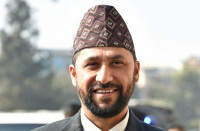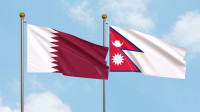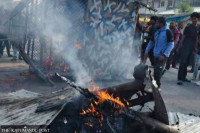National
As Ratna Park gets new name and statues of two icons, many say ‘let history be history’
At the centre of Kathmandu, the city has memorialised the lives of Sankhadhar Sakhwa and Padma Ratna Tuladhar but the step has sparked a debate about recording history.
Srizu Bajracharya
Legend has it that Vikram Sambat, the official calendar of Nepal, is named after King Vikramaditya of Ujjain in Madhya Pradesh, India and he initiated it after having won a war.
However, the calendar that was initiated in Nepal is Nepal Sambat celebrated in November every year. It was initiated by Sankhadhar Sakhwa, a philanthropist, after he paid the debt of the people of Nepal Valley, as Kathmandu Valley was known then.
Understandably, the Newars of Kathmandu revere him.
“Sankhadhar Sakhwa represents the Nepal Valley and our native history,” said Suraj Maharjan, a Newa activist.
According to Kashinath Tamot, a 75-year-old linguist and cultural expert, there are about 36 memorials of Sankhadhar Sakhwa already within Kathmandu Valley of which the best known is the Sankhadhar Chowk in Thimi, Bhaktapur where his statue is visited by dignitaries on Nepal Sambat new year’s day. This year was a different matter, given the pandemic.
As if that was not enough, on November 21 Kathmandu Metropolitan City re-renamed a park at the heart of Kathmandu Sankadhar Udhyan, or garden after unveiling a statue of the national hero and also another of Padma Ratna Tuladhar, a leftist politician and cultural activist who died in 2018.
The move has invited widespread criticism.
“By bringing them under the shadow of the queen who is still alive, they are disrespecting everything, even the accords and transition from monarchy to a democratic republic,” said Tamot.
The late king Mahendra established Ratna Park in 1964 and named it after his second wife, the sister of his first wife who had died, carving it from Tundikhel, or Tinkhya as the Newars of Kathmandu called the open space.
Ratna, 94, the former queen mother, is still alive and lives in Mahendra Manjil, her home within the Narayanhiti Palace Museum complex.
Her bust which stood at the entrance of the park was removed during the people’s movement of 2006 that ushered in republicanism, ending 240 years of the Shah reign in Nepal. In its place Sankhadhar Sakhwa’s statue was unveiled by Urban Development Minister Krishna Gopal Shrestha on November 21.
“It does not make sense to change a name that is already so well known and established,” said Bijay Shrestha, coordinator of the Occupy Tundikhel movement. “We shouldn’t be imposing a history that has already been established. Regardless of the fact that people like it or not, they represent their own chronicle.”
In the popular imagination, Ratna Park is where the Valley’s bus terminus is. Those going to the city centre get on a bus to Ratna Park.
Ratna Park also represents a political history as a mark of the monarchy that has now fallen. During the two people’s movements—in 1990 that ushered in multiparty democracy and in 2006, Ratna Park was also a space for democratic presence that spread out from the adjoining Khula Manch.
“A name sets forth everything,” said Tamot, the cultural expert. “That is perhaps why Kathmandu Metropolitan City’s action to change the name of Ratna Park has started a huge argument.”
Besides the name, people are also upset about commemorating Sankhadhar Sakhwa as a national figure together with Padma Ratna Tuladhar as their contributions to society don’t match.
“I got riled up just reading about it. Because it was not necessary at all and if they had wished to honour the legendary national figure Sankhadhar Sakhwa and the human rights activist Padma Ratna Tuladhar, they should have sought to do it in a better way than trying to rewrite the history,” said Jainendra Jeevan, a political commentator and columnist.
This is the second time that Kathmandu Metropolitan City has named the park Sankhadhar Udhyan.
In 2017, as part of the park’s redevelopment, it had given the park the new name Sankhadhar Udhyan.
“He is a national figure of the country, one that people look up to and we thought it would be okay to have him up there,” said Ishwor Man Dangol, spokesperson for the Kathmandu Metropolitan City. "We did this for the people with regard to their sentiments for Sakhwa."
For Dangol and many in the Metropolitan City, the criticism was quite unexpected as they had been using the name Sankhadhar Udhyan for three years now. “We had also hoisted a signboard at the area as part of redeveloping Ratna Park,” he told the Post over phone.
“But we just changed the name of the park, the place is still Ratnapark,” said Dangol.
However, Dangol’s clarification in the media has not appeased many. The Post’s efforts to get in touch with Mayor Bidya Sundar Shakya and Deputy Mayor Hari Prabha Khadgi were unsuccessful as they refused to talk.
“But almost 60 years have come to pass, and there is a whole history attached to this place, and so, in a way, this attempt seems to be erasing a marked history,” said Shrestha, the heritage activist.
But the metropolitan city has its supporters too in this regard.
Maharjan, the Newa activist, says that the new name, Sankhadhar Udhyan is good and justifiable. “For years, native names have been changed and places encroached upon. In that aspect, I see this as a part of reclaiming our lost history,” he said.
But others, including federal and provincial parliamentarians, remain unconvinced.
“I had told Krishna Gopal Shrestha [the minister] when meeting him during an event that they shouldn’t place the memorials there together because the park already has an established history,” said Bhimsen Das Pradhan, a member of parliament from Kathmandu and former defence minister. “[This] feels wrong and shows how they have disrespected the previous agreements and the whole history.”
Jeewan Dangol, a member of the Bagmati Provincial Assembly, also shares the view.
“If they had wished to honour Sankhadhar Sakhwa and Padma Ratna Tuladhar, they should have sought a different place. This just disregards the point of why they were doing it in the first place,” she said.
One Twitter user last Saturday pointed out how there already is a Sankhadhar Sakhwa park along the Bishnumati promenade which today remains unmanaged and abandoned.
Kathmandu Metropolitan City could even have built a different park to commemorate the contributions of Sankhadhar Sakhwa and Padma Ratna Tuladhar, according to others.
“We don’t have enough open spaces, and they could have invested in a new open space or looked to accumulate the history in the open spaces that already exist in alignment with their contribution,” said Shrestha, the coordinator of Occupy Tundikhel.
There, however, is an overwhelming consensus that the two figures have to be given their dues and their contributions commemorated.
“I think it is great that KMC wanted to acknowledge Sakhwa and Tuladhar. It is admirable no doubt but in choosing a space that already has a history, they are wrong,” said Tamot. “For a new name replaces history and the mark of a time. But they both have independent identities.”
Others see that this move by Kathmandu Metropolitan City could set a precedence for more unpleasantness and unnecessary debate.
“There are just so many names we already have attached to a certain history, and if we are to change them, this will unravel in a never-ending process; we don’t need to rewrite history. But this is now going to go on,” said Jeevan, the political commentator.




 11.12°C Kathmandu
11.12°C Kathmandu













%20(1).jpg&w=300&height=200)

